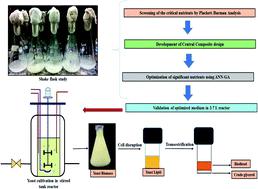当前位置:
X-MOL 学术
›
Sustain. Energy Fuels
›
论文详情
Our official English website, www.x-mol.net, welcomes your feedback! (Note: you will need to create a separate account there.)
Multi-fold enhancement in sustainable production of biomass, lipids and biodiesel from oleaginous yeast: an artificial neural network-genetic algorithm approach
Sustainable Energy & Fuels ( IF 5.6 ) Pub Date : 2020-10-15 , DOI: 10.1039/d0se00922a RaviRanjan Kumar 1, 2, 3 , Gunaseelan Dhanarajan 1, 2, 3 , Debasis Sarkar 2, 3, 4 , Ramkrishna Sen 1, 2, 3
Sustainable Energy & Fuels ( IF 5.6 ) Pub Date : 2020-10-15 , DOI: 10.1039/d0se00922a RaviRanjan Kumar 1, 2, 3 , Gunaseelan Dhanarajan 1, 2, 3 , Debasis Sarkar 2, 3, 4 , Ramkrishna Sen 1, 2, 3
Affiliation

|
Oleaginous yeasts have emerged as a much favored feedstock for sustainable production of biomass, lipids and biodiesel because of their higher growth rates, greater lipid contents and ease of cultivation as compared to plants or microalgae. In this study, the Plackett–Burman design was first implemented for screening the critical nutrients and then an artificial neural network modelling coupled with genetic algorithm (ANN-GA) technique was employed for enhancing the lipid content in Meyerozyma caribbica (earlier reported as Pichia guilliermondii) with greater biomass yield. Plackett–Burman screening experiments indicated that glycerol, ammonium chloride, magnesium sulphate and potassium dihydrogen phosphate were the most influential media components, whose concentrations were subsequently optimized by applying the ANN-GA technique. The optimized media, while doubling the biomass concentration, resulted in an enhanced lipid yield of 0.49 ± 0.02 g g−1, which is approximately 2.5 fold the initial starting value as obtained in a 3.7 L fermenter. Based on gas chromatographic analysis of a fatty acid methyl ester (FAME) profile, the ratio of saturated to unsaturated fatty acids was found to be 44.5 : 55.9, which is considered as most favorable combination for biodiesel applications. The biodiesel properties also conformed to the ASTM D6751 and EN 14214 specifications, thereby making it a marketable clean and green biodiesel product. Thus, the present study showcases successful implication of an advanced media optimization strategy for multi-fold enhancement of biomass and lipid yields for sustainable production of biodiesel as a renewable fuel using Meyerozyma caribbica.
中文翻译:

油脂酵母可持续生产生物质,脂质和生物柴油的多重提高:人工神经网络-遗传算法
含油酵母由于与植物或微藻相比具有较高的生长速率,较高的脂质含量和易于培养的优点,已成为可持续生产生物质,脂质和生物柴油的备受青睐的原料。在这项研究中,首先采用Plackett-Burman设计来筛选关键营养素,然后采用人工神经网络建模与遗传算法(ANN-GA)技术结合来提高加勒比肉芽孢杆菌的脂质含量(先前报道为毕赤酵母))具有更高的生物量产量。Plackett-Burman筛选实验表明,甘油,氯化铵,硫酸镁和磷酸二氢钾是最具影响力的培养基成分,其浓度随后通过ANN-GA技术进行了优化。优化的培养基在使生物质浓度增加一倍的同时,使脂质产量提高了0.49±0.02 gg -1约为3.7 L发酵罐中初始起始值的2.5倍。根据脂肪酸甲酯(FAME)谱的气相色谱分析,发现饱和脂肪酸与不饱和脂肪酸之比为44.5:55.9,被认为是生物柴油应用中最有利的组合。生物柴油的特性还符合ASTM D6751和EN 14214规范,因此使其成为可销售的清洁绿色生物柴油产品。因此,本研究展示了一种先进的培养基优化策略的成功含义,该策略可以多重提高生物质和脂质的产量,从而可持续利用Carybica Meyerozyma作为可再生燃料生产生物柴油。
更新日期:2020-11-03
中文翻译:

油脂酵母可持续生产生物质,脂质和生物柴油的多重提高:人工神经网络-遗传算法
含油酵母由于与植物或微藻相比具有较高的生长速率,较高的脂质含量和易于培养的优点,已成为可持续生产生物质,脂质和生物柴油的备受青睐的原料。在这项研究中,首先采用Plackett-Burman设计来筛选关键营养素,然后采用人工神经网络建模与遗传算法(ANN-GA)技术结合来提高加勒比肉芽孢杆菌的脂质含量(先前报道为毕赤酵母))具有更高的生物量产量。Plackett-Burman筛选实验表明,甘油,氯化铵,硫酸镁和磷酸二氢钾是最具影响力的培养基成分,其浓度随后通过ANN-GA技术进行了优化。优化的培养基在使生物质浓度增加一倍的同时,使脂质产量提高了0.49±0.02 gg -1约为3.7 L发酵罐中初始起始值的2.5倍。根据脂肪酸甲酯(FAME)谱的气相色谱分析,发现饱和脂肪酸与不饱和脂肪酸之比为44.5:55.9,被认为是生物柴油应用中最有利的组合。生物柴油的特性还符合ASTM D6751和EN 14214规范,因此使其成为可销售的清洁绿色生物柴油产品。因此,本研究展示了一种先进的培养基优化策略的成功含义,该策略可以多重提高生物质和脂质的产量,从而可持续利用Carybica Meyerozyma作为可再生燃料生产生物柴油。



























 京公网安备 11010802027423号
京公网安备 11010802027423号